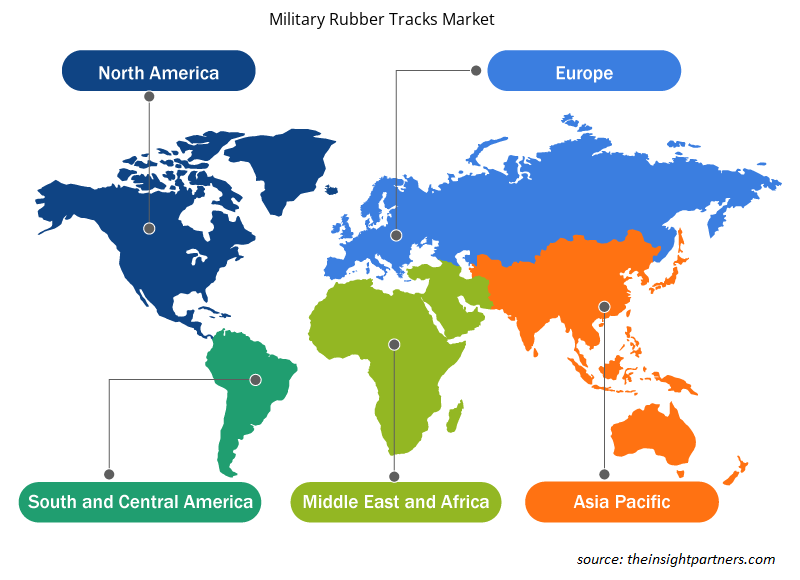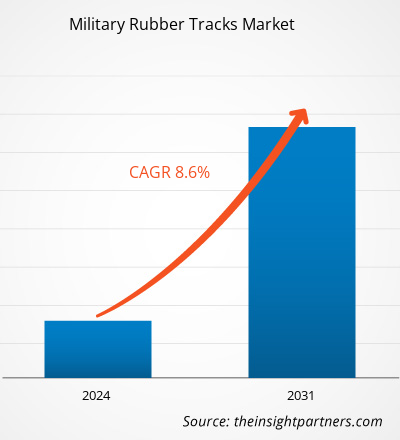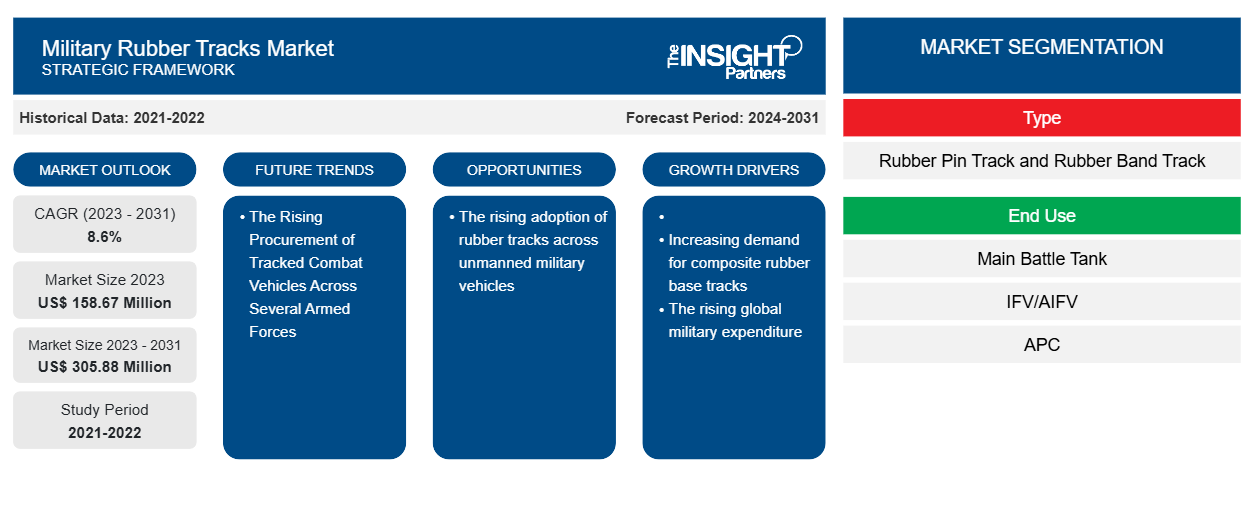Der Markt für militärische Gummiketten soll von 158,67 Millionen US-Dollar im Jahr 2023 auf 305,88 Millionen US-Dollar im Jahr 2031 anwachsen. Der Markt wird zwischen 2023 und 2031 voraussichtlich eine durchschnittliche jährliche Wachstumsrate von 8,6 % verzeichnen. Der zunehmende Einsatz von Gummiketten zur Deckung der steigenden Produktion unbemannter Militärfahrzeuge dürfte ein wichtiger Trend auf dem Markt bleiben.
Militärische Gummiketten Marktanalyse
Das Ökosystem des Militärgummikettenmarktes besteht aus den folgenden Interessengruppen: Rohstofflieferanten, Hersteller von Militärgummiketten und Endverbraucher. Die Rohstofflieferanten liefern Materialien wie Gummi, Polymere und Metall zur Herstellung von Militärgummiketten. Die Hersteller von Militärgummiketten führen Prozesse wie Design und Produktion durch, um Rohmaterial in das fertige Produkt umzuwandeln. Die Hersteller von Militärgummiketten verkaufen ihre Produkte an verschiedene Endverbraucher, wie beispielsweise die Streitkräfte. Dies hilft den Herstellern, höhere Umsätze zu erzielen und katalysiert so das Wachstum des Militärgummikettenmarktes.
Marktübersicht für Militärgummiketten
Obwohl Gummiketten bei verschiedenen Arten von Militärfahrzeugen schnell Anklang gefunden haben , werden Stahlketten aufgrund ihrer Haltbarkeit auf hartem Gelände überwiegend bevorzugt. Gummiketten sind auf rauen Oberflächen wie Hügeln und Bergen weniger haltbar als Stahlketten. Stahlketten bieten aufgrund ihres Gewichts und ihrer Lastverteilung auf Schlamm und verschneiten Oberflächen auch mehr Traktion. Gummiketten sind temperaturempfindlich; sie werden bei Kälte spröde und bei Hitze formbar. Beim Einsatz unter rauen Wetterbedingungen stehen die Streitkräfte vor Herausforderungen bei der Verwendung von Gummiketten oder Gummipolstern im Vergleich zu Stahlketten. Solche Faktoren haben den Markt für militärische Gummiketten beeinflusst.
Passen Sie diesen Bericht Ihren Anforderungen an
Sie erhalten kostenlos individuelle Anpassungen an jedem Bericht, einschließlich Teilen dieses Berichts oder einer Analyse auf Länderebene, eines Excel-Datenpakets sowie tolle Angebote und Rabatte für Start-ups und Universitäten.
-
Holen Sie sich die wichtigsten Markttrends aus diesem Bericht.Dieses KOSTENLOSE Beispiel umfasst eine Datenanalyse von Markttrends bis hin zu Schätzungen und Prognosen.
Treiber und Chancen auf dem Militärgummikettenmarkt
Zunehmende Nutzung von Gummiverbundketten (Composite Rubber Tracks, CRTs) in militärischen Anwendungen
Die Vorteile von Verbundgummiketten (CRTs) gegenüber herkömmlichen Stahlgummiketten (SRTs) sind geringerer Wartungsaufwand, geringere Belastung bei höherer Haltbarkeit und bessere Austauschhäufigkeit. SRTs erfordern Wartung von Komponenten wie Verbindungsgliedern, Kettenrädern und Laufrädern, die alle 600 km ausgetauscht werden müssen, wohingegen CRTs ein wartungsarmes Produkt sind, das bis zu 5000 km ohne Wartung oder Austausch von Strukturkomponenten laufen kann. Darüber hinaus ist der Kraftstoffverbrauch von Militärfahrzeugen auf CRT-Basis viel geringer als der von Militärfahrzeugen auf SRT-Basis. Laut der Analyse der Insight-Partner sind gepanzerte Mannschaftstransportwagen (APCs) und Schützenpanzer (IFVs) mit Stahlketten effizienter als solche mit CRTs und sparen mindestens 30 % Kraftstoff.
Die steigende Beschaffung von Kettenfahrzeugen bei mehreren Streitkräften
Zu den wichtigsten Akteuren auf dem globalen Markt für militärische Gummiketten zählen Astrak UK Limited, DST Defence Service Tracks GmbH, GMT Rubber-Metal-Technic Ltd und Mackay Consolidated Industries Pty Ltd. Diese Unternehmen schließen ständig neue Verträge zur Lieferung von Gummiketten an verschiedene Hersteller von Militärfahrzeugen auf der ganzen Welt ab, da die Beschaffung von Militärkettenfahrzeugen durch verschiedene Streitkräfte zunimmt:
- Im April 2024 vergab die US-Armee einen Auftrag im Wert von 754 Millionen US-Dollar an BAE Systems Plc für den Beginn der zweiten Phase der Herstellung gepanzerter Mehrzweckfahrzeuge (AMPVs).
- Im Juli 2023 erhielt General Dynamics Land Systems von der US-Armee einen Auftrag im Wert von 257,6 Millionen US-Dollar für die zweite Phase der Low Rate Initial Production des neu benannten M10 Booker Combat Vehicle (26 Einheiten), früher bekannt als Mobile Protected Firepower.
Eine derartige Beschaffung von militärischen Kettenfahrzeugen dürfte den Anbietern auf dem Markt für militärische Gummiketten in den kommenden Jahren neue Möglichkeiten eröffnen.
Segmentierungsanalyse des Marktberichts für Militärgummiketten
Schlüsselsegmente, die zur Ableitung der Marktanalyse für militärische Gummiketten beigetragen haben, sind Typ und Endverwendung.
- Je nach Typ ist der Markt für Militärgummiketten in Gummistiftketten und Gummibandketten unterteilt. Das Segment der Gummistiftketten hatte im Jahr 2023 einen größeren Marktanteil.
- Basierend auf der Endverwendung ist der Markt für militärische Gummiketten in Kampfpanzer, IFV/AIFV, APC und andere unterteilt. Das APC-Segment hatte im Jahr 2023 einen größeren Marktanteil.
Militärische Gummiketten Marktanteilsanalyse nach Geografie
Der geografische Umfang des Marktberichts für militärische Gummiketten ist hauptsächlich in fünf Regionen unterteilt: Nordamerika, Europa, Asien-Pazifik, Naher Osten und Afrika sowie Südamerika.
Nordamerika dominierte den Markt im Jahr 2023, gefolgt von Europa und dem asiatisch-pazifischen Raum. Darüber hinaus wird der asiatisch-pazifische Raum in den kommenden Jahren wahrscheinlich die höchste durchschnittliche jährliche Wachstumsrate verzeichnen. Angesichts des wachsenden Fokus auf die Verbesserung der Manövrierfähigkeit gepanzerter Fahrzeuge und der Erhöhung des staatlichen Budgets für die Beschaffung moderner gepanzerter Fahrzeuge sowie der zunehmenden Wartung, Reparatur und Überholung (MRO) militärischer gepanzerter Fahrzeuge wird der Markt für Gummiketten im Prognosezeitraum voraussichtlich einen deutlichen Aufschwung erleben. Die Vereinigten Staaten haben den höchsten Verteidigungshaushalt der Welt. Die Militärausgaben des Landes beliefen sich im Jahr 2022 auf 876,94 Milliarden US-Dollar und stiegen im Jahr 2023 auf 916 Milliarden US-Dollar. Northern Plains Track und Hutchinson Industries Inc. sind die wichtigsten Unternehmen, die militärische Gummiketten in den USA anbieten. Solche Faktoren haben das Wachstum des nordamerikanischen Marktes für militärische Gummiketten vorangetrieben.
Regionale Einblicke in den Markt für Militärgummiketten
Die regionalen Trends und Faktoren, die den Markt für Militärgummiketten während des gesamten Prognosezeitraums beeinflussen, wurden von den Analysten von Insight Partners ausführlich erläutert. In diesem Abschnitt werden auch die Marktsegmente und die Geografie von Militärgummiketten in Nordamerika, Europa, im asiatisch-pazifischen Raum, im Nahen Osten und Afrika sowie in Süd- und Mittelamerika erörtert.

- Erhalten Sie regionale Daten zum Militär-Gummikettenmarkt
Umfang des Marktberichts über militärische Gummiketten
| Berichtsattribut | Details |
|---|---|
| Marktgröße im Jahr 2023 | 158,67 Millionen US-Dollar |
| Marktgröße bis 2031 | 305,88 Millionen US-Dollar |
| Globale CAGR (2023 - 2031) | 8,6 % |
| Historische Daten | 2021-2022 |
| Prognosezeitraum | 2024–2031 |
| Abgedeckte Segmente |
Nach Typ
|
| Abgedeckte Regionen und Länder |
Nordamerika
|
| Marktführer und wichtige Unternehmensprofile |
|
Dichte der Marktteilnehmer für militärische Gummiketten: Auswirkungen auf die Geschäftsdynamik verstehen
Der Markt für Militärketten aus Gummi wächst rasant, angetrieben durch die steigende Nachfrage der Endnutzer aufgrund von Faktoren wie sich entwickelnden Verbraucherpräferenzen, technologischen Fortschritten und einem größeren Bewusstsein für die Vorteile des Produkts. Mit der steigenden Nachfrage erweitern Unternehmen ihr Angebot, entwickeln Innovationen, um die Bedürfnisse der Verbraucher zu erfüllen, und nutzen neue Trends, was das Marktwachstum weiter ankurbelt.
Die Marktteilnehmerdichte bezieht sich auf die Verteilung von Firmen oder Unternehmen, die in einem bestimmten Markt oder einer bestimmten Branche tätig sind. Sie gibt an, wie viele Wettbewerber (Marktteilnehmer) in einem bestimmten Marktraum im Verhältnis zu seiner Größe oder seinem gesamten Marktwert präsent sind.
Die wichtigsten auf dem Markt für Militärgummiketten tätigen Unternehmen sind:
- Astray UK Limited
- DST Defence Service Tracks GmbH
- GMT Gummi-Metall-Technik GmbH
- Mackay Consolidated Industries Pty Ltd
- Martin's Rubber Company Limited
Haftungsausschluss : Die oben aufgeführten Unternehmen sind nicht in einer bestimmten Reihenfolge aufgeführt.

- Überblick über die wichtigsten Akteure auf dem Markt für Militärgummiketten
Neuigkeiten und aktuelle Entwicklungen zum Markt für militärische Gummiketten
Der Markt für militärische Gummiketten wird durch die Erhebung qualitativer und quantitativer Daten nach Primär- und Sekundärforschung bewertet, die wichtige Unternehmensveröffentlichungen, Verbandsdaten und Datenbanken umfasst. Nachfolgend sind einige der Entwicklungen auf dem Markt für militärische Gummiketten aufgeführt:
Die Canadian Commercial Corporation (CCC) freut sich bekannt zu geben, dass sie vom US-Verteidigungsministerium (US DoD) einen Auftrag zur Lieferung von T-107 Ground Side Kevlar Rubber von Soucy Techno an die US-Armee erhalten hat. (Quelle: Excella, Pressemitteilung, April 2024)
- Rheinmetall, der größte Lieferant von Militärfahrzeugen für die australischen Streitkräfte, hat Demonstrationstests des Soucy Composite Rubber Track (CRT)-Systems am Schützenpanzer Lynx KF41 erfolgreich abgeschlossen. (Quelle: Rheinmetall AG, Pressemitteilung, Nov. 2021)
Marktbericht zu Gummiketten für das Militär – Umfang und Ergebnisse
Der Bericht „Marktgröße und Prognose für militärische Gummiketten (2021–2031)“ bietet eine detaillierte Analyse des Marktes, die die folgenden Bereiche abdeckt:
- Militärische Gummiketten Marktgröße und Prognose auf globaler, regionaler und Länderebene für alle wichtigen Marktsegmente, die im Rahmen des Berichts abgedeckt sind
- Militärische Gummiketten Markttrends sowie Marktdynamik wie Treiber, Einschränkungen und wichtige Chancen
- Detaillierte Porter-Fünf-Kräfte-Analyse
- Analyse des Marktes für militärische Gummiketten mit wichtigen Markttrends, globalen und regionalen Rahmenbedingungen, wichtigen Akteuren, Vorschriften und aktuellen Marktentwicklungen
- Branchenlandschaft und Wettbewerbsanalyse, die die Marktkonzentration, Heatmap-Analyse, prominente Akteure und aktuelle Entwicklungen auf dem Markt für Militärgummiketten umfasst
- Detaillierte Firmenprofile
- Historische Analyse (2 Jahre), Basisjahr, Prognose (7 Jahre) mit CAGR
- PEST- und SWOT-Analyse
- Marktgröße Wert/Volumen – Global, Regional, Land
- Branchen- und Wettbewerbslandschaft
- Excel-Datensatz
Aktuelle Berichte
Verwandte Berichte
Erfahrungsberichte
Grund zum Kauf
- Fundierte Entscheidungsfindung
- Marktdynamik verstehen
- Wettbewerbsanalyse
- Kundeneinblicke
- Marktprognosen
- Risikominimierung
- Strategische Planung
- Investitionsbegründung
- Identifizierung neuer Märkte
- Verbesserung von Marketingstrategien
- Steigerung der Betriebseffizienz
- Anpassung an regulatorische Trends























 Kostenlose Probe anfordern für - Markt für Militärgummiketten
Kostenlose Probe anfordern für - Markt für Militärgummiketten